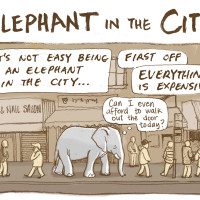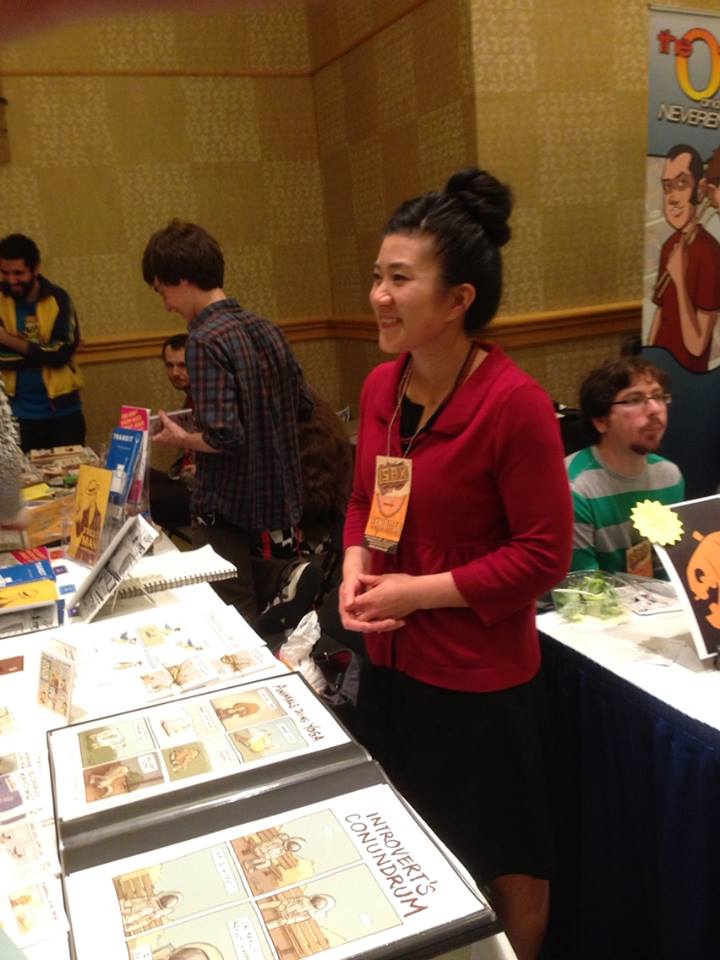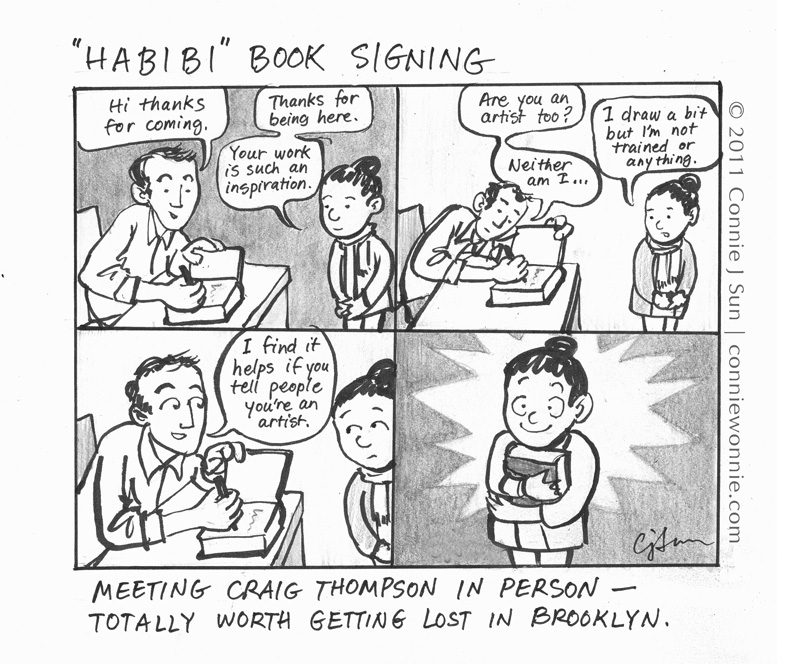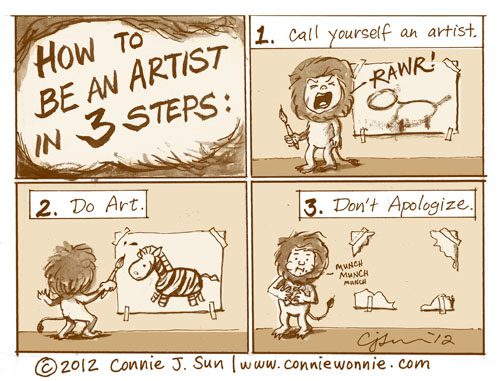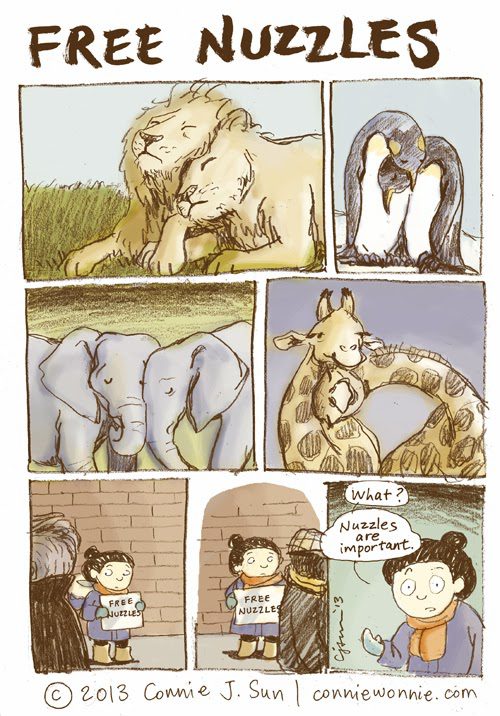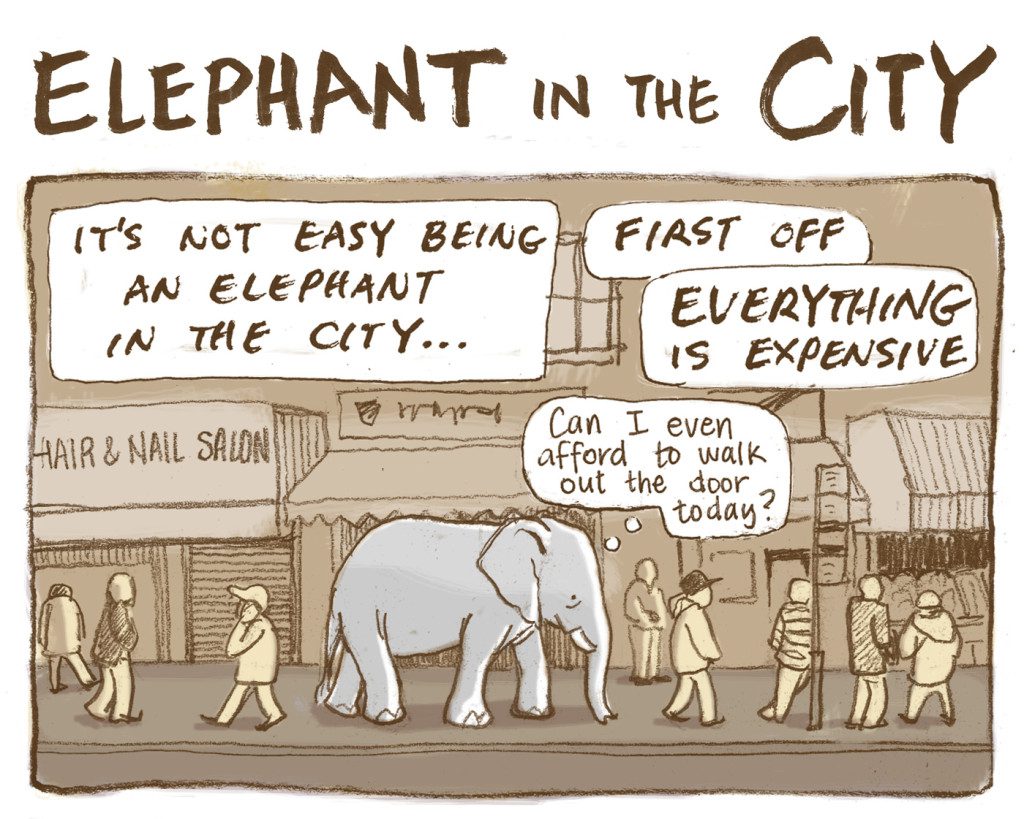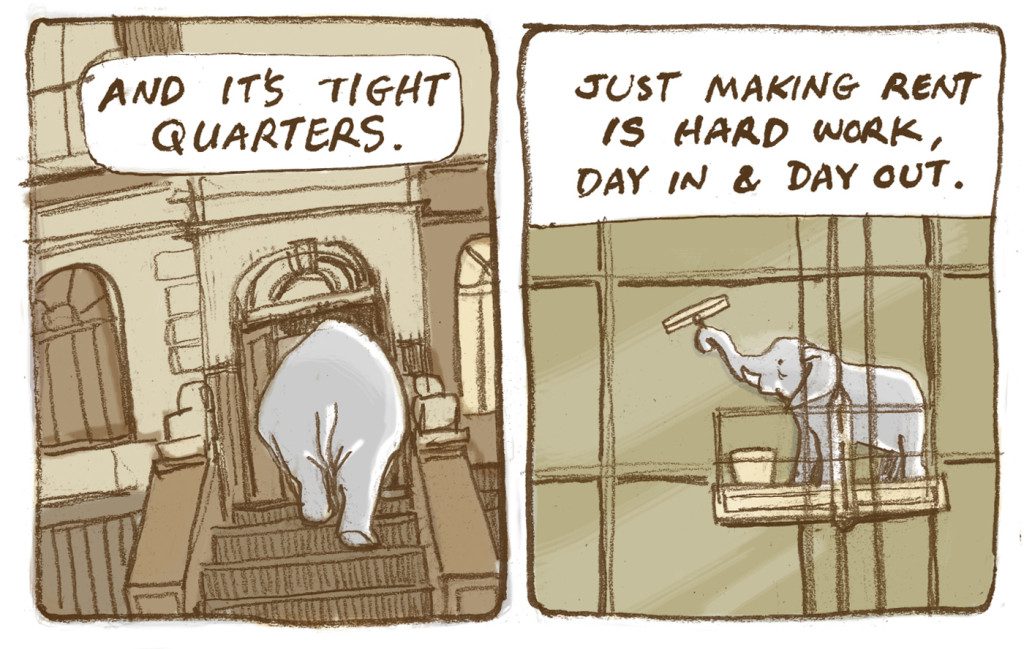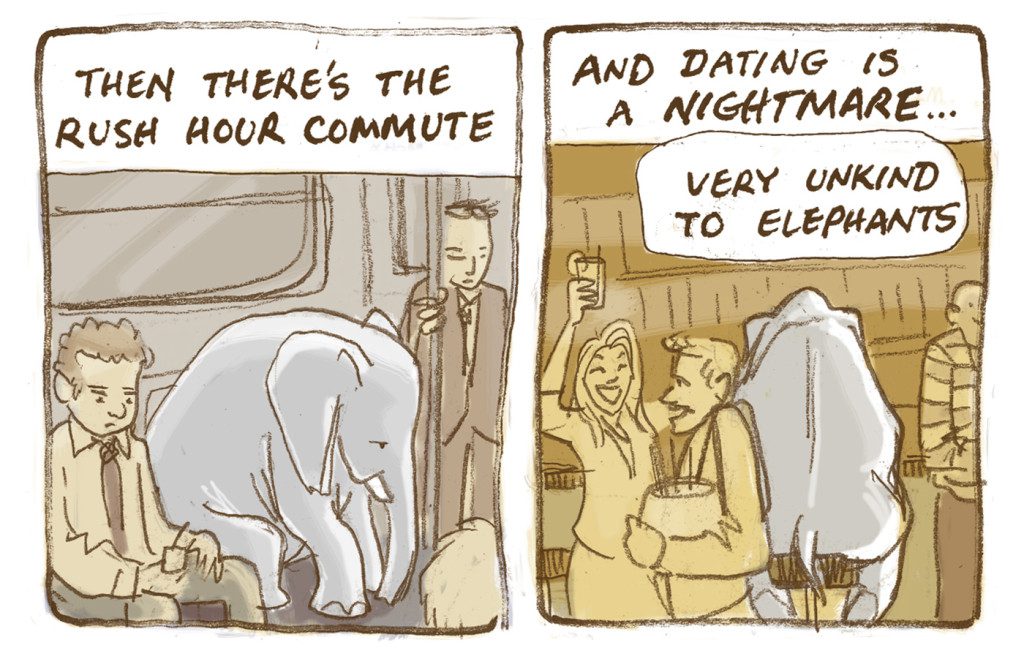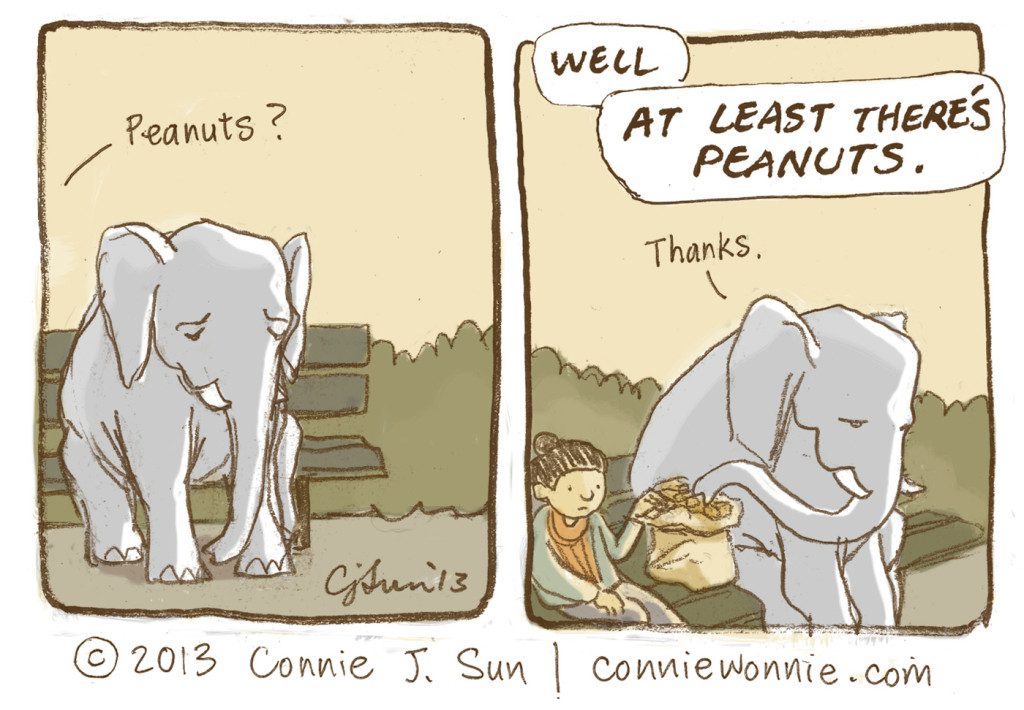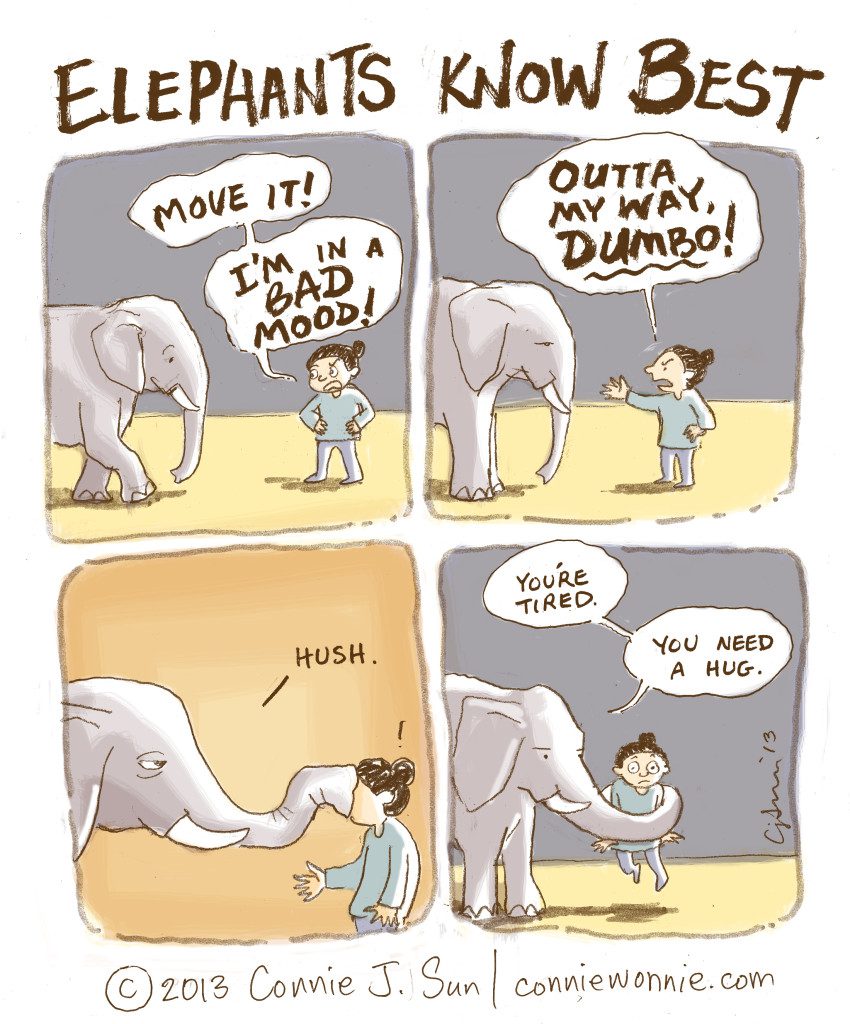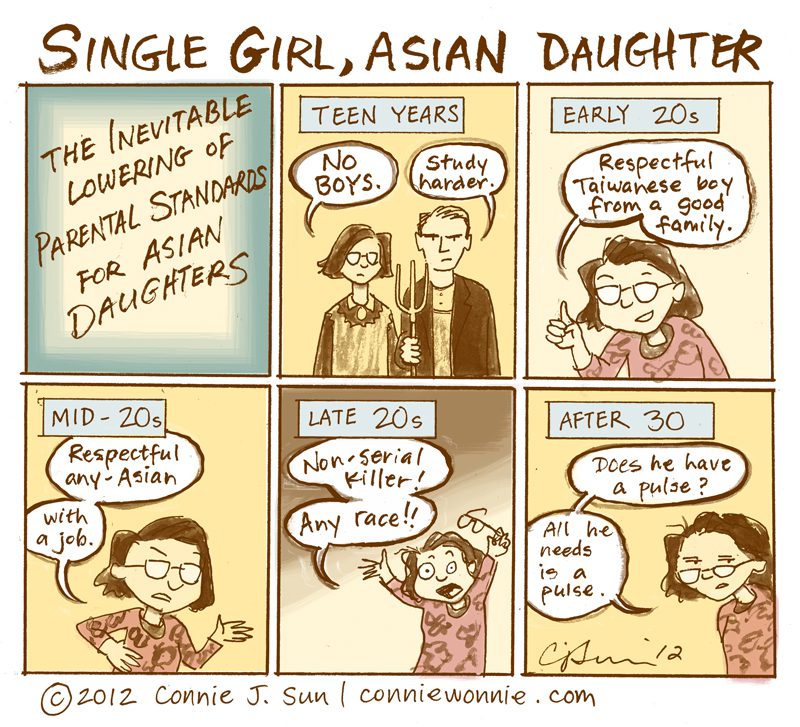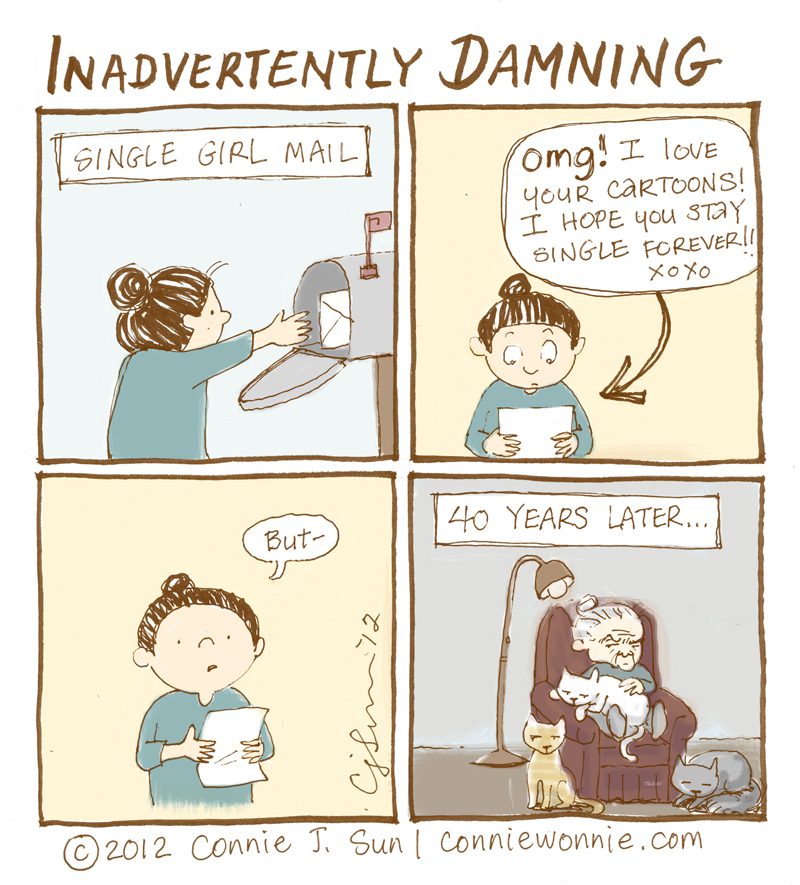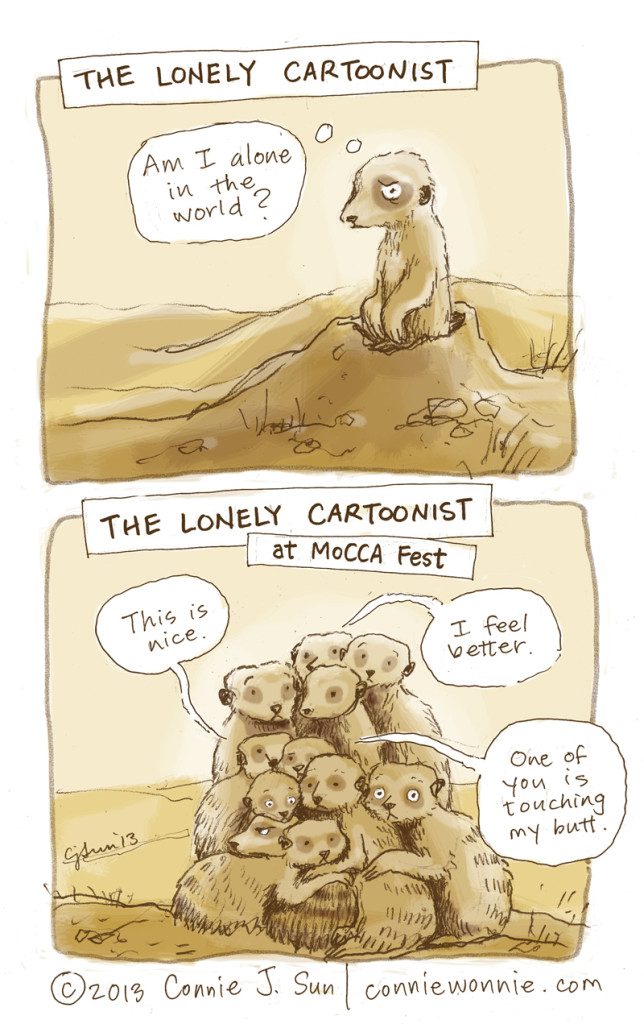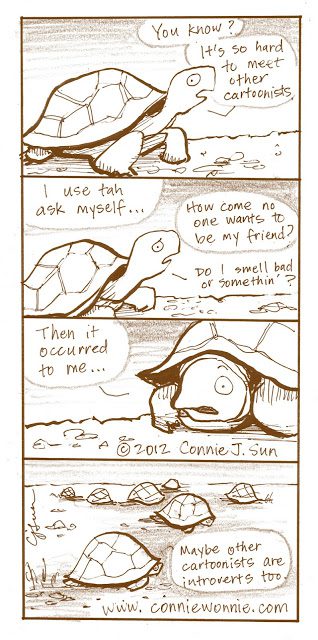The New York Comics & Picture-Story Symposium is a weekly forum for discussing the tradition and future of text/image work. Open to the public, it meets Tuesday nights from 7 to 9 PM EST in New York City. Presentations vary weekly and include everything from historical topics and technical demonstrations to creators presenting their work. Check out upcoming meetings here.
Connie Sun is a New-York based cartoonist who posts a daily comic on her website Connie to the Wonnie. The Rumpus had the pleasure of talking with her about her work:
The Rumpus: In your symposium presentation, you described starting to make your daily webcomic and joining the symposium as a way to learn more about comics. Can you talk about how you encountered comics before now? Did you make them before 2011? Were there particular comics you found especially compelling?
I came to comics late, as an adult. I grew up reading newspaper comic strips, like Peanuts and Calvin and Hobbes, but not comic books. When I bought my first graphic novel at a comic book store, I was 29, single, and living in NYC. I told a college friend of mine what I had done and, prophetically, he said, “Welcome to comics. Your life is over for the next 2 years.”
It’s been 4 and I haven’t looked back. As I started reading more comics, I was inspired and overwhelmed by how much there was. It felt foreign, but I wanted to somehow be a part of it. It took me a couple of years before I was even comfortable with calling myself an artist or cartoonist. (This was one of my cartoons about meeting Craig Thompson and his advice to me:
Graphic memoirs and travelogues were what initially drew me in and, from there, I learned to appreciate a wider range of styles and subject matter. Luckily for me, I found that New York is an amazing place for comics.
Rumpus: Can you describe starting your webcomic? Why a daily? and has the experience of making it has changed a lot for you over time?
Not surprisingly, reading comics made me want to make my own. I had always like to draw and write, but I separated the two. Comics showed me way to put them together. My first frustrated attempts were kind of like poorly constructed sentences in a language I didn’t speak. So there was a long learning curve. Learning to make comics has been a lot like learning another language. In much the same way, comprehension comes before the ability to produce anything intelligible, so I’ve had to learn to be patient with myself.
The decision to start doing a daily webcomic came from the immediate need for a creative outlet. I work full-time and I recognized that I needed to also carve out a creative space for myself. I felt I had something I needed to say, but I couldn’t quite find the “words.”
Doing an “illustrated status message a day” seemed like a reasonable challenge at the beginning, but it was definitely harder than I imagined. The first year of cartooning felt like doing battle with myself: all my fears, doubts, insecurities on top of learning new skills – basically, the artistic process in a nutshell. That was the first hurdle. After I exhausted that subject matter, I could go beyond it and it freed me up to explore other subject matter.
Rumpus: What kinds of stories or subject matter appeal to you? Can you go into what your process is like?
I’m interested in emotions and how we process what happens in our day-to-day lives. On personal level, making comics is how I access my emotions.
As for my process, I draw a lot from personal experience. I keep a running notebook of ideas. Typically, I get up in the morning, make tea, and check in with myself, with how I’m feeling. On a good day, it’s straightforward; other days, it’s harder. A lot of the time, how I feel is not immediately obvious to me and I have to tease it out. Gradually and with practice, cartooning has become a vehicle for me to do so.
But then, since it’s my mandate, I have to finish and post a cartoon before I leave for work in the morning, so there is a limit to how much I can mull. The deadline is crucial I think.
Another important piece is letting your work go. As with most creative endeavors, there’s risk involved, so a big part of the process is learning to let it go. If I’m dissatisfied with a cartoon, I say, “Well this is crap, but it’s what I’m able to do today. And tomorrow is another day.” I have a lot of days like that, but I have to forgive myself or I wouldn’t be able to make anything at all.
Rumpus: What about nature and animals interests you? Do you find that living in a city affects this interest in any way?
My fascination with animals might just be anthropomorphic. I grew up in the suburbs of Los Angeles and we didn’t have pets – so I don’t have much hands-on experience with animals. After I moved New York, one of my roommates had a dog which I would dog-sit occasionally. That was the first time I realized how differently dogs experience the world compared to humans. In my mind, there is no significant difference between human nature and animal nature.
On a more basic level, drawing animals sometimes comforts me and reminds me that the way we see the world is not the only way. That said, I don’t really understand animals – and human behavior kind of baffles me too.
Rumpus: What are your favorite comics? Do you get inspiration from other sources like movies, tv, fine art, the news, etc?
I grew up with Calvin and Hobbes, so those comic strips are firmly embedded in my psyche. I also loved children’s books and the illustrations of Maurice Sendak, Norman Rockwell, and Jules Feiffer. These days, I love a good thick graphic novel, but I’m also really enjoying short-form comics, like Lewis Trondheims’s Little Nothings, Boulet’s long-running webcomic, the work of Gabrielle Bell, Kate Beaton, and Grant Snider – there’s so much to be inspired by. Lately, I’ve been interested in how artists use color in comics and, this past year, Gregory Benton’s B + F and Miriam Katin’s Letting It Go totally opened up my world.
I also draw a lot of inspiration from stand-up comedy which I started exploring around the same time that I started reading comics. Both taught me to look at the world in different ways, the power of reframe, humor in processing things that happen in life. Inspiration comes from who and what I encounter in my day-to-day and what is emotionally immediate to me. I’m often trying to get myself to the other side of a feeling. If I can find humor in something, then somehow it’s more bearable. Being able to laugh at yourself is the closest thing I can think of to a superpower in life.
Rumpus: Your comic often explores the absurdity of how your brain works and how other people behave. Is there something that keeps surprising you about how people decide to act or how your mind reacts to things?
Absurd is a good word. It makes me think of Beckett’s Waiting for Godot and Charlie Todd’s TED Talk where he discusses starting Improv Everywhere as a way to elicit the “shared experience of absurdity” in everyday situations. I don’t pretend to understand how anything works, but my cartoons are an attempt to make sense of what I see and hear and feel at a given time. It’s a messy, complicated, contradictory, and sometimes hilarious process for all of us, I think.
Rumpus: What has it been like representing yourself in your comic? Especially for exploring your “single woman” theme and “asian daughter” theme?
The avatar I draw of myself is a vehicle to explore situations and things I feel. It’s not straight autobiography, but I do draw material from my life, so the character I’ve created has become a reference point for me. It’s a cue that I’m writing from a specific perspective and context. It helps me explore things in comics form that I may not be able to do in real life. Comics artist Simon Fraser gave me feedback once that I would have more creative freedom if I distanced myself from the character. Hopefully, I’m inching in that direction, but my subject matter is still very much in the realm of reality.
As for the “Single Girl, Asian Daughter” theme, talking about it in comic form gets it out in the open and allows me to explore the highs and lows of a specific scenario. Being able to laugh at a situation also defuses it in a way.
This cartoon has been the most popular by far and it appears that there are a lot of us out there who can relate to being single and reconciling parental expectations.
Rumpus: What materials do you use?
For the daily comics, I draw on paper with pencil and brush pens, scan the line work, and color it digitally with a Wacom tablet and Photoshop. That has been the routine so far, but I’m learning as I go, so all of this may change!
Rumpus: What has it been like entering the comics world? You’re a mainstay at the symposium, you exhibited for the first time at SPX this past fall, you go to cons and events, you were just featured on the Comics Beat; I’m curious what your impressions are.
When I didn’t know anyone in comics, the first people I met were pro-cartoonists Jennifer Hayden and Simon Fraser. They were so friendly and encouraging that I stuck with it – it kept me going. Soon after, I met Karen Green and Nick Sousanis at Columbia University, Ben Katchor through the NY Comics and Picture-Story Symposium, and Robert Sikoryak and Kriota Willberg at Carousel events, all of which opened to door to meeting so many other creators and wonderful people who inspire me every day. Tom Motley who edits the comics section of the Brooklyn Rail gave me my first opportunity to see two of my cartoons in print. Heidi MacDonald, who makes it her business to take the pulse of the industry, is always helping get the word out on new cartoonists on the Comics Beat. It’s a great resource for anyone new to the scene. My impressions? Comics people are good people.
Rumpus: Since you do a webcomic, I’m wondering what your experience has been like with feedback and with the online comics community?
I haven’t really thought of webcomics as a community separate from the broader comics community. There are a lot of great cartoonists who work I follow, but the community I feel most connected to are people who I see face-to-face. Ben Katchor’s NY Comics Symposium has been an incredible watering hole for people interested in comics. I’ve met so many of my artists friends through those weekly meetings in the past year. I love reading comics in print and online, but I think meeting people in person is really important in reinforcing the sense that you are not doing this alone.
 Rumpus: Where would you like to go from here? Or are there things you’re curious about doing now that you weren’t 3 years ago?
Rumpus: Where would you like to go from here? Or are there things you’re curious about doing now that you weren’t 3 years ago?
I have the tendency to live inside my head too much. For me, making comics is still a very inward-looking process. When I first started, I probably felt a little lonely and isolated. By putting my work out there, I’ve come in contact with some amazing and generous people and am starting to feel a part of something larger. But making comics is still a solitary activity for me. That’s one of my limitations. It’s straight from my brain to the page. I’m fascinated by how people do collaborative and interdisciplinary projects. It sounds challenging, but it’s a direction I’d like to push myself in.
In news, starting later this month, I’ll be joining GoComics.com, so readers will have another place to read my webcomic. I’m excited about this! Also, in April, I’ll be tabling for the first time at MoCCAFest in New York which I’m also super stoked about. I think it’s going to be a lot of fun and there are people I can’t wait to see and hang out with. This has been the best part: finding a whole community of cartoonists!
***
Image Credits:
Slyly taken photo of Connie Sun at her table by Andrea Tsurumi, September 2013 at SPX
All comics © Connie Sun
***
Andrea Tsurumi is a NY-based illustrator and cartoonist who likes her robots sad and her history funny. She is the recipient of a 2013 MOCCA Award and was included in the 2013 Best American Comics notables list. You can see her work here and her latest projects here.
